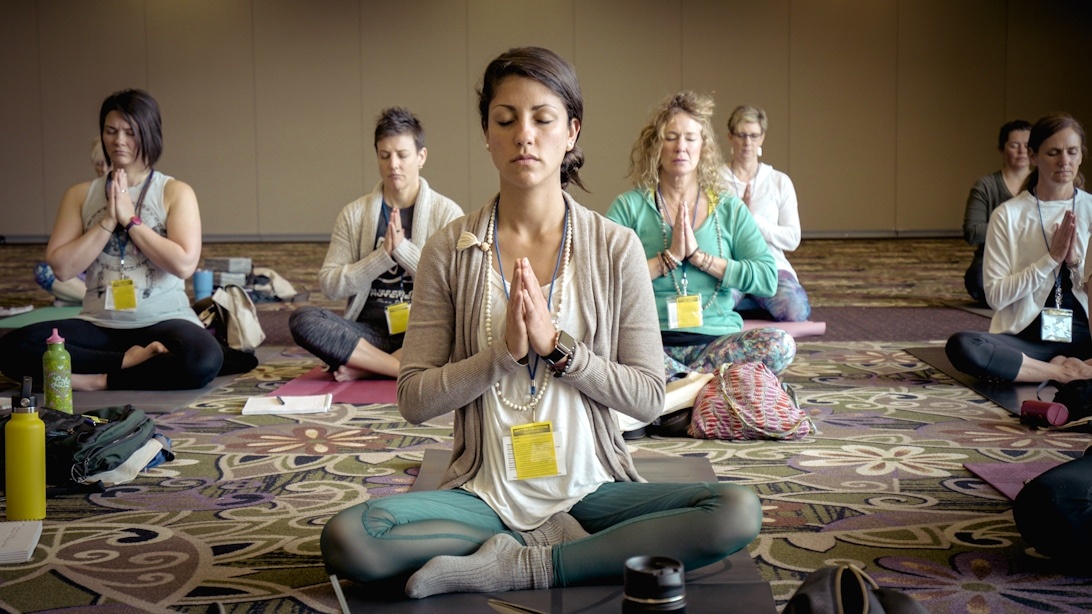In a world where screens constantly demand our attention, it’s easy for our bodies to suffer. Hours spent in front of the computer, tablet, or phone leave their mark, often as slumped posture, tense shoulders, and an aching neck. But there’s hope! Yoga offers a fantastic path back to a stronger, more balanced, and pain-free body. Let’s explore together how we can use the power of yoga to counteract the challenges of digital life and rediscover a proud, healthy posture in 2025.
Why screen time harms our posture
We live in a fascinating digital age, but our bodies weren’t originally designed to sit still and stare at screens for long periods. The typical ’computer posture’ – with shoulders rounded forward, upper back hunched, and head jutting forward – has become increasingly common. This position, sometimes called ’tech neck,’ puts enormous strain on the neck vertebrae. The head’s weight, normally around 4-5 kilos (9-11 lbs), can feel significantly heavier – potentially equivalent to 25 kilos (55 lbs) according to some sources – when pushed forward, creating immense stress on the muscles, ligaments, and discs in the neck and back. This not only leads to pain and stiffness in the neck, shoulders, and back but can also affect our breathing, energy levels, and even our mood. Many of us recognize that dull ache between the shoulder blades or the tension headache that creeps up after a long workday. It’s the body’s way of signaling that something isn’t right.
The problem often starts lower down than we might think. A sedentary lifestyle can lead to tight hip flexors and weakened core muscles, which in turn affects the natural curvature of the spine. When the lower back loses its curve or the upper back becomes excessively rounded, the neck is forced to compensate, leading to that forward head position. Stress, a common companion in digital life, often worsens the situation by causing unconscious muscle tension, especially in the shoulders and neck. Ergonomics also plays a significant role; a poorly adjusted workspace can force us into awkward positions. Over time, these factors can lead to muscle imbalances and chronic issues, making it harder to maintain good posture even when we’re away from the screen.
How yoga strengthens your posture
This is where yoga comes in as a saving grace. Yoga is so much more than just physical postures; it’s a holistic practice that unites body, mind, and breath. When it comes to posture, yoga offers a unique combination of strength, flexibility, and body awareness that’s hard to find in other forms of exercise. Through regular yoga practice, we strengthen the muscles crucial for good posture – especially the deep core muscles and the muscles along the spine and between the shoulder blades. Think of it as building a strong internal ’corset’ that supports the spine and helps us sit and stand tall effortlessly.
Simultaneously, we work on increasing flexibility in areas that often become stiff from sitting, like the chest muscles, shoulders, and hip flexors. By gently and consciously stretching these muscles, we create more space in the body and counteract that slumped feeling. A crucial aspect, often emphasized in yoga, is body awareness. By directing our attention inward, we learn to recognize the body’s signals and become aware of our own postural habits. This awareness, sometimes referred to as ’Yoga Danda awareness’ (an awareness of the spine’s alignment, almost like an inner supportive staff), is key to correcting posture not just on the yoga mat but also in everyday life – when sitting at the computer, waiting for the bus, or cooking dinner. Conscious breathing, deeply connected to yoga, also plays a vital role. Deep breaths, especially during chest-opening poses, can expand the rib cage, improve lung capacity hindered by poor posture, and calm the nervous system, reducing stress-related tension. Research also supports yoga’s positive effects; studies show that yoga can reduce lower back and neck pain and improve physical function, which is directly linked to better posture.
Practical yoga exercises for your digital life
So, how can we specifically use yoga to improve posture? The great thing is that there are many ways to integrate yoga into daily life, whether you’re a beginner or an experienced practitioner. It doesn’t have to involve long, advanced sessions every day. Even short moments of conscious movement can make a big difference.
Backbends to open the front body
To counteract the forward-leaning posture, backbends are invaluable. They open the chest, stretch the front of the shoulders, and strengthen the back muscles. Poses like Cobra (Bhujangasana), Sphinx, and Bridge (Setu Bandhasana) are excellent options that can be adapted to your level. Consciously breathing into the chest during these poses enhances the opening effect. Even more intense backbends like Wheel (Urdhva Dhanurasana) can be powerful for actively counteracting the effects of computer work, but remember to always listen to your body and build strength gradually.
Soften neck and shoulders
Tension in the neck and shoulders are common companions to screen time. Simple exercises can provide immediate relief and improve mobility. Try these:
- Neck Stretches: Sit comfortably with a straight back and relaxed shoulders. Gently tilt your head to one side, as if trying to touch your shoulder with your ear. Hold for a few breaths and switch sides. You can also gently turn your head from side to side.
- Shoulder Rolls: Place your fingertips on your shoulders. Make large, slow circles with your elbows, first forward and then backward. Feel the shoulder blades moving and tension releasing.
- Garudasana (Eagle Arms): Extend your arms straight forward. Cross your right arm over your left at the elbow. Bend the elbows and try to bring the palms towards each other. Gently lift the elbows and feel the stretch between the shoulder blades. Hold for a few breaths and switch sides. This exercise is super effective for releasing tension.
Strengthen your core and back
Strong core muscles are the foundation of good posture. Poses like Plank, Boat (Navasana), and various Warrior poses (Virabhadrasana) help build strength and stability. Also, postural yoga, which specifically focuses on activating the deep postural muscles to correct imbalances, can be very effective in creating a more natural posture. By strengthening these muscles, we give the spine the support it needs.
Yin yoga for deep release
In addition to more dynamic forms of yoga, Yin Yoga can be incredibly beneficial. By holding poses for a longer duration (often 3-5 minutes), we affect the body’s deeper connective tissues (fascia). This can help release chronic tension and improve mobility on a deeper level. Poses like Sphinx, Supported Bridge, and various reclining twists are common in Yin Yoga and can be particularly good for counteracting stiffness in the back and neck caused by extensive screen time. These longer holds also encourage mindful breathing and relaxation.
Integrate into your daily routine
The most important thing is to find a way to make yoga part of your routine. Perhaps you can take a 5-10 minute break during the workday for some simple stretches? Or why not start or end the day with a short yoga session? There are fantastic resources online, like Hatha Yoga classes specifically for posture or shorter, versatile sessions focusing on posture and stiff shoulders. Even Pilates-inspired exercises using a flexband can be a great addition for strengthening the upper body while seated. Try this 5-minute reset: During a break ”`html In a world where screens constantly demand our attention, it’s easy for our bodies to suffer. Hours spent in front of the computer, tablet, or phone leave their mark, often as slumped posture, tense shoulders, and an aching neck. But there’s hope! Yoga offers a fantastic path back to a stronger, more balanced, and pain-free body. Let’s explore together how we can use the power of yoga to counteract the challenges of digital life and rediscover a proud, healthy posture in 2025. We live in a fascinating digital age, but our bodies weren’t originally designed to sit still and stare at screens for long periods. The typical ’computer posture’ – with shoulders rounded forward, upper back hunched, and head jutting forward – has become increasingly common. This position, sometimes called ’tech neck,’ puts enormous strain on the neck vertebrae. The head’s weight, normally around 4-5 kilos (9-11 lbs), can feel significantly heavier – potentially equivalent to 25 kilos (55 lbs) according to some sources – when pushed forward, creating immense stress on the muscles, ligaments, and discs in the neck and back. This not only leads to pain and stiffness in the neck, shoulders, and back but can also affect our breathing, energy levels, and even our mood. Many of us recognize that dull ache between the shoulder blades or the tension headache that creeps up after a long workday. It’s the body’s way of signaling that something isn’t right. The problem often starts lower down than we might think. A sedentary lifestyle can lead to tight hip flexors and weakened core muscles, which in turn affects the natural curvature of the spine. When the lower back loses its curve or the upper back becomes excessively rounded, the neck is forced to compensate, leading to that forward head position. Stress, a common companion in digital life, often worsens the situation by causing unconscious muscle tension, especially in the shoulders and neck. Ergonomics also plays a significant role; a poorly adjusted workspace can force us into awkward positions. Over time, these factors can lead to muscle imbalances and chronic issues, making it harder to maintain good posture even when we’re away from the screen. This is where yoga comes in as a saving grace. Yoga is so much more than just physical postures; it’s a holistic practice that unites body, mind, and breath. When it comes to posture, yoga offers a unique combination of strength, flexibility, and body awareness that’s hard to find in other forms of exercise. Through regular yoga practice, we strengthen the muscles crucial for good posture – especially the deep core muscles and the muscles along the spine and between the shoulder blades. Think of it as building a strong internal ’corset’ that supports the spine and helps us sit and stand tall effortlessly. Simultaneously, we work on increasing flexibility in areas that often become stiff from sitting, like the chest muscles, shoulders, and hip flexors. By gently and consciously stretching these muscles, we create more space in the body and counteract that slumped feeling. A crucial aspect, often emphasized in yoga, is body awareness. By directing our attention inward, we learn to recognize the body’s signals and become aware of our own postural habits. This awareness, sometimes referred to as ’Yoga Danda awareness’ (an awareness of the spine’s alignment, almost like an inner supportive staff), is key to correcting posture not just on the yoga mat but also in everyday life – when sitting at the computer, waiting for the bus, or cooking dinner. Conscious breathing, deeply connected to yoga, also plays a vital role. Deep breaths, especially during chest-opening poses, can expand the rib cage, improve lung capacity hindered by poor posture, and calm the nervous system, reducing stress-related tension. Research also supports yoga’s positive effects; studies show that yoga can reduce lower back and neck pain and improve physical function, which is directly linked to better posture. So, how can we specifically use yoga to improve posture? The great thing is that there are many ways to integrate yoga into daily life, whether you’re a beginner or an experienced practitioner. It doesn’t have to involve long, advanced sessions every day. Even short moments of conscious movement can make a big difference. To counteract the forward-leaning posture, backbends are invaluable. They open the chest, stretch the front of the shoulders, and strengthen the back muscles. Poses like Cobra (Bhujangasana), Sphinx, and Bridge (Setu Bandhasana) are excellent options that can be adapted to your level. Consciously breathing into the chest during these poses enhances the opening effect. Even more intense backbends like Wheel (Urdhva Dhanurasana) can be powerful for actively counteracting the effects of computer work, but remember to always listen to your body and build strength gradually. Tension in the neck and shoulders are common companions to screen time. Simple exercises can provide immediate relief and improve mobility. Try these: Strong core muscles are the foundation of good posture. Poses like Plank, Boat (Navasana), and various Warrior poses (Virabhadrasana) help build strength and stability. Also, postural yoga, which specifically focuses on activating the deep postural muscles to correct imbalances, can be very effective in creating a more natural posture. By strengthening these muscles, we give the spine the support it needs. In addition to more dynamic forms of yoga, Yin Yoga can be incredibly beneficial. By holding poses for a longer duration (often 3-5 minutes), we affect the body’s deeper connective tissues (fascia). This can help release chronic tension and improve mobility on a deeper level. Poses like Sphinx, Supported Bridge, and various reclining twists are common in Yin Yoga and can be particularly good for counteracting stiffness in the back and neck caused by extensive screen time. These longer holds also encourage mindful breathing and relaxation. The most important thing is to find a way to make yoga part of your routine. Perhaps you can take a 5-10 minute break during the workday for some simple stretches? Or why not start or end the day with a short yoga session? There are fantastic resources online, like Hatha Yoga classes specifically for posture or shorter, versatile sessions focusing on posture and stiff shoulders. Even Pilates-inspired exercises using a flexband can be a great addition for strengthening the upper body while seated. Try this 5-minute reset: During a break, do 1 minute of neck stretches (30 seconds each side), 1 minute of shoulder rolls (30 seconds forward, 30 backward), 1 minute of Eagle Arms (30 seconds each side), and finish with 2 minutes in Sphinx pose, breathing deeply to open the chest. Remember that even small, regular efforts make a big difference over time. Working on your posture through yoga isn’t just a quick fix for aching shoulders; it’s an investment in your long-term health and well-being. Good posture isn’t about rigidly holding yourself in an unnatural way, but about finding the body’s natural balance and strength. When we stand and sit with a more upright and relaxed posture, not only does our physical health improve – we can experience better breathing, increased energy, and even boosted confidence and mood, as some wellness approaches suggest. I’ve personally noticed how a mindful yoga practice, even brief moments, helps me restore balance after hours at the computer. It’s about creating a dialogue with your body, listening to its signals, and giving it the movement and care it needs. By integrating yoga and training to improve posture, we take an active step towards feeling better in our digital daily lives. Some studios even offer specific courses to improve posture and reduce back pain, which can be a great way to get guidance. So let’s roll out the mat, take a few deep breaths, and give our bodies the attention they deserve. Your posture is the foundation you stand on – nurture it well.
Why screen time harms our posture
How yoga strengthens your posture
Practical yoga exercises for your digital life
Backbends to open the front body
Soften neck and shoulders
Strengthen your core and back
Yin yoga for deep release
Integrate into your daily routine
Your posture is your foundation: An investment for life


